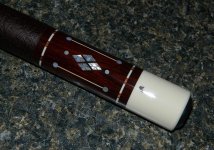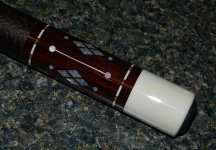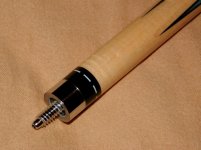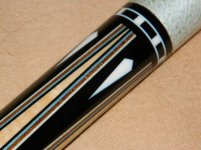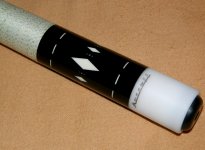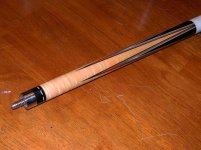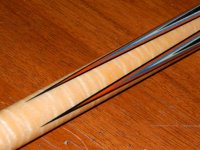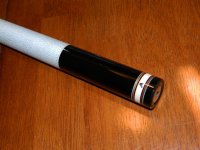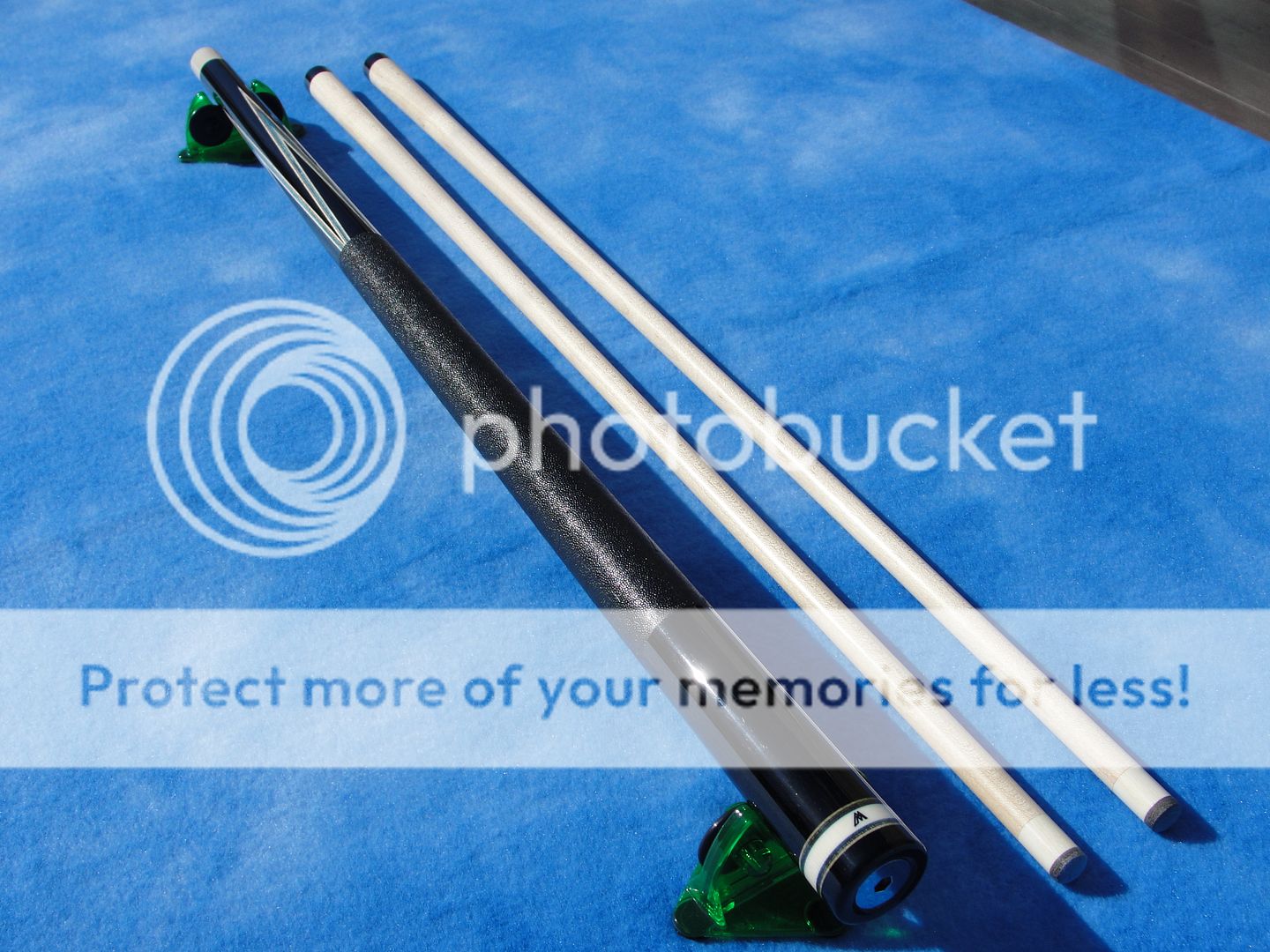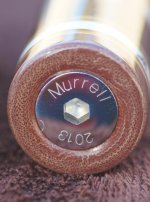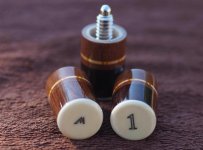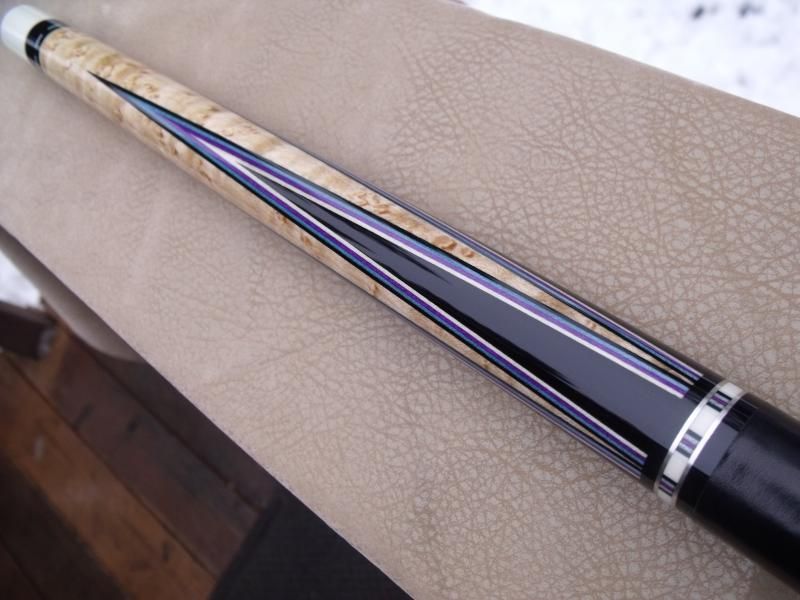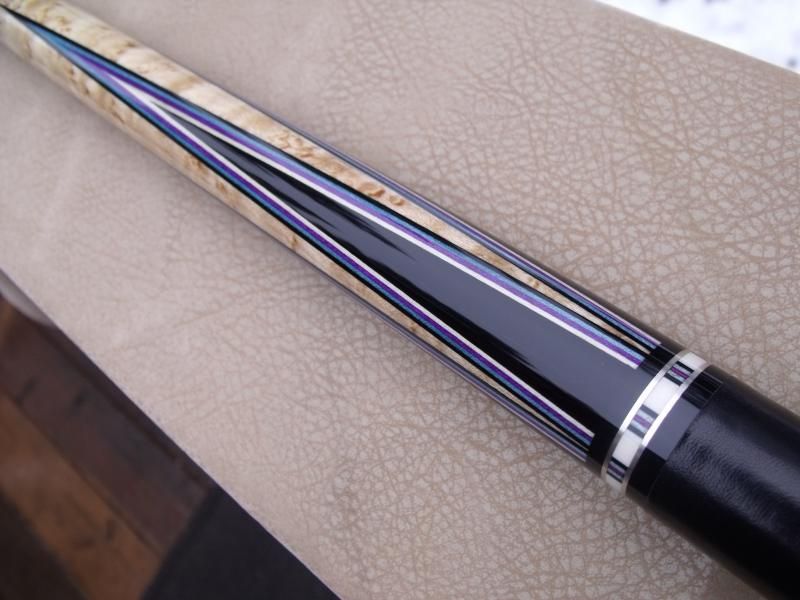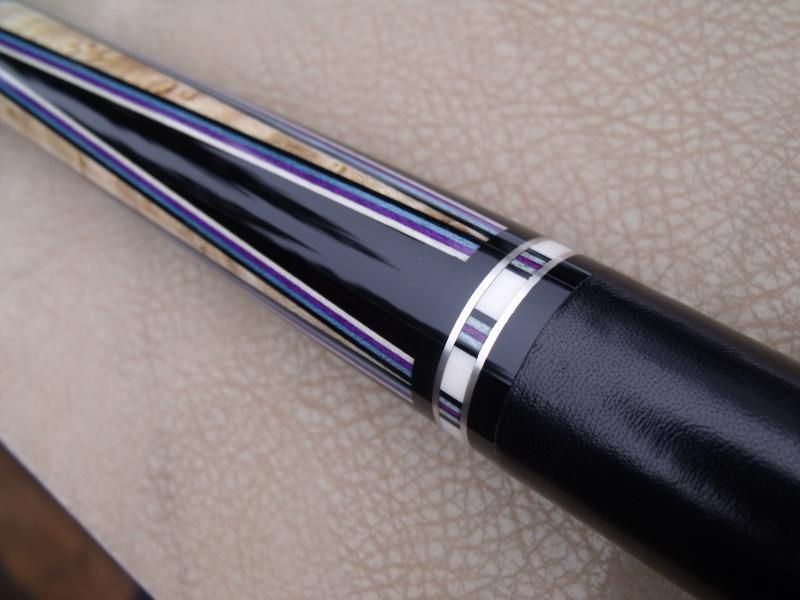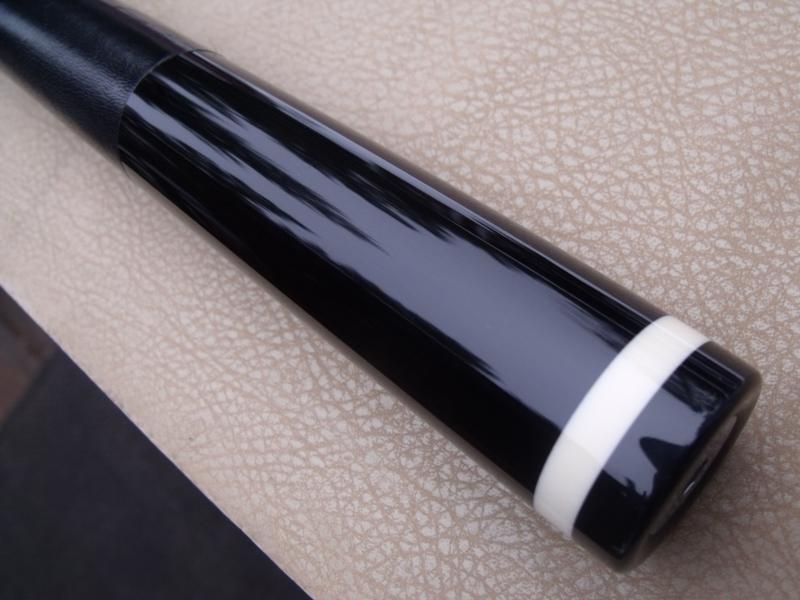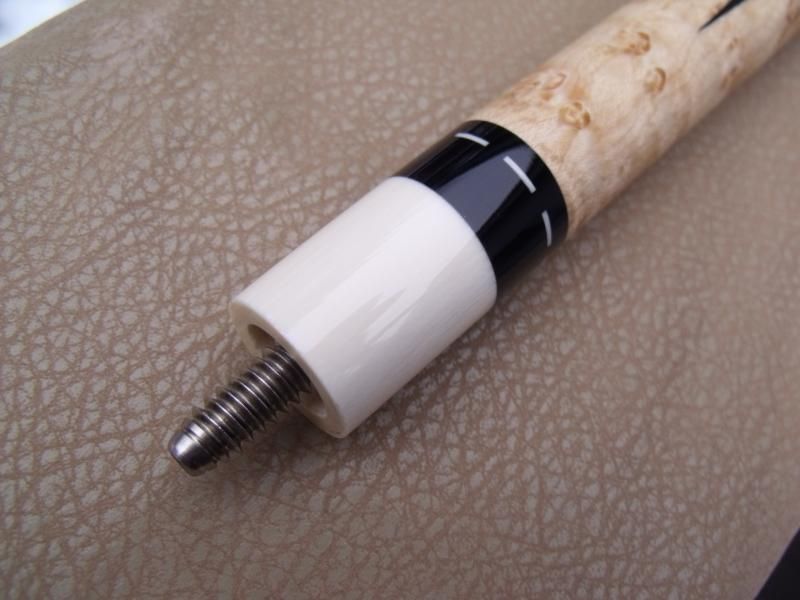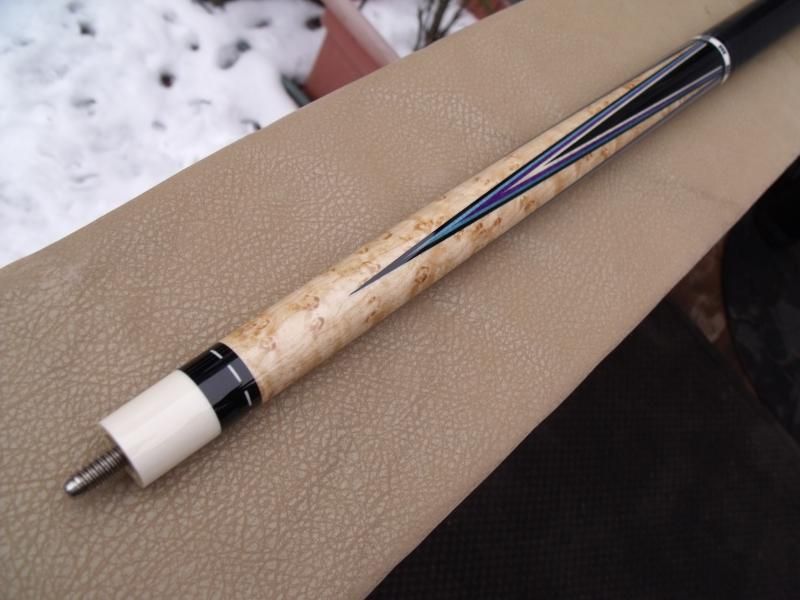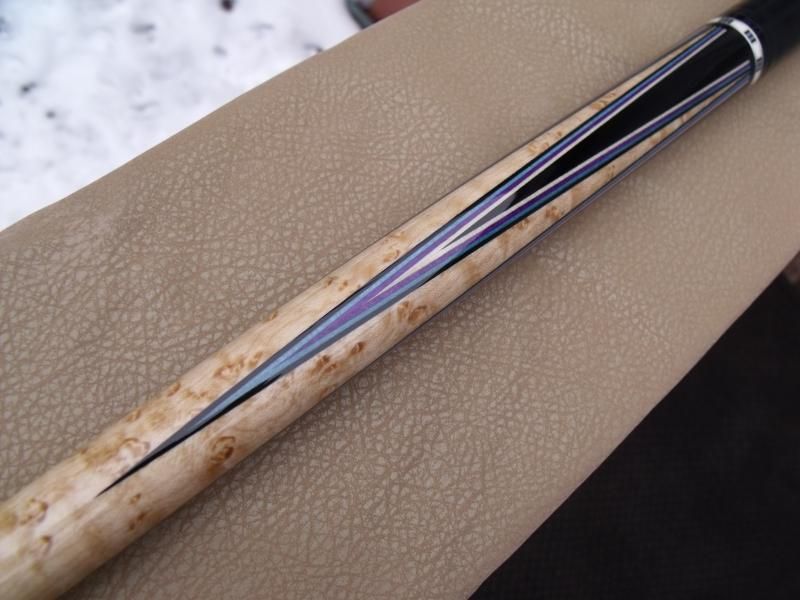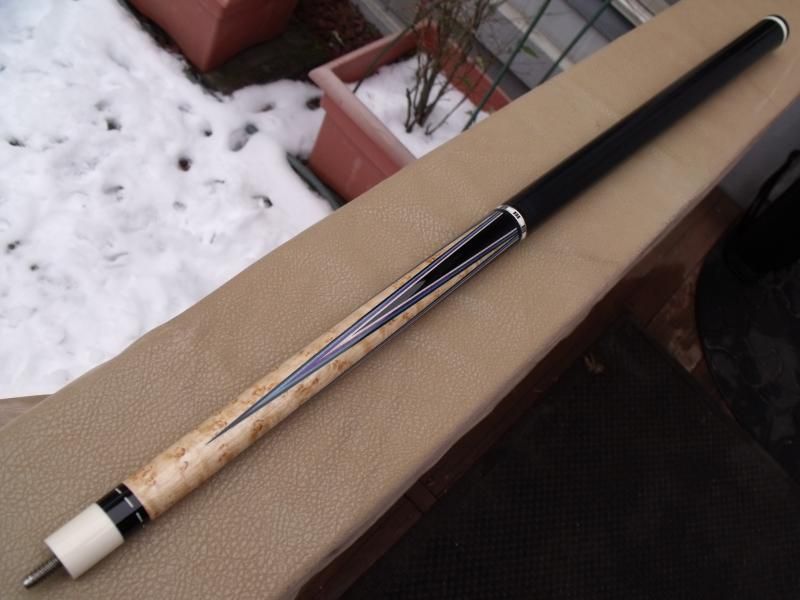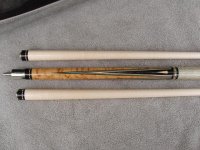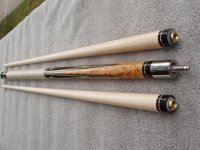You are using an out of date browser. It may not display this or other websites correctly.
You should upgrade or use an alternative browser.
You should upgrade or use an alternative browser.
Please Post some 2012-2013 Murrell
- Thread starter wawacue
- Start date
Back to top. Want to see some more post of Kenny Murrell cues for 2013 and 2014 cues:thumbup:
Any more?
Josh
Josh
Ivory over stainless ,,,, mmmm-m
I love this Ebony Murrell with the ivory over stainless joint, Something like this might make me give up my Ebony veneered Lambros,, :thumbup2: ,,,,< ED
Last edited:
I love this Ebony Murrell with the ivory over stainless joint, Something like this might make me give up my Ebony veneered Lambros,, :thumbup2: ,,,,< ED
Hi, Ed.
Just a quick one. When I was talking to Kenny about the cue I wanted, he said that if looked like ivory,
but was steel lined, it was a Juma joint. His solid ivory joints are just straight piloted.. not ivory over
stainless (as in Srober40's pics in post #11). Great looking cue no matter what the joint material is though :wink:
Chris
Last edited:
Here's my late 2013 Murrell with an ivory joint. In fact, everything white
on the cue and the joint protectors is ivory. Kenny is great to work with,
and makes a fantastic cue. If anyone dislike the all barbell styling, don't
blame Kenny. That was my bright idea
Chris.
on the cue and the joint protectors is ivory. Kenny is great to work with,
and makes a fantastic cue. If anyone dislike the all barbell styling, don't
blame Kenny. That was my bright idea
Chris.
Attachments
Last edited:
Hi, Ed.
Just a quick one. When I was talking to Kenny about the cue I wanted, he said that if looked like ivory,
but was steel lined, it was a Juma joint. His solid ivory joints are just straight piloted.. not ivory over
stainless (as in Srober40's pics in post #11). Great looking cue no matter what the joint material is though :wink:
Chris
my order is ivory over SS joint......
Last edited:
my order is ivory over SS joint......
I have known to be mistaken before :smile: When I contacted Kenny to build my cue, he said that any steel sleeved (for lack of a better term) joints were juma, and that his ivory joints were always solid ivory. As it seems my info in no longer correct, I hope that everyone disregards my post and reads yours.
Chris
Help me out here........what's the benefit of an ivory sleeve over a piloted steel joint other creating than a faux appearance
of the cue having an ivory joint. I mean isn't an ivory cue joint really just either flat faced or piloted steel?
Perhaps an early piloted, i.e. old, piloted ivory joint might conceivably use a brass pin rather than steel. But the thin ivory
sleeve that surrounds the steel can't do much to differentiate the feel and ensuing vibration transfer process that results
from striking the cue ball compared with a piloted steel joint. Sure it looks like it's an ivory joint but it's a far cry from flat
faced or piloted ivory joint like Paul Mottey was famous for making.
Like I said, other than making the assembled cue appear like an ivory joint cue, what's the reason or benefit. I mean if you
want an ivory joint, why not just get one on your cue and enjoy the difference. Am I out in the left field about sleeved ivory?
I recall Richard Black's very first cue joint (flat faced steel) that was a flop and he quickly switched to using the same joint
as George Balabushka (piloted steel 5/16x14). But what's the purpose of a thin ivory sleeve other than for art deco?
I cannot recall any cue-maker noted for using ivory sleeve cue joints so there must be a reason, or so it would other wise
suggest......Hmn....Interesting? Anyway, it just seems like an ivory sleeve joint's very design does little to differentiate the
overall feel of the cue stroke due to the minimal amount of ivory involved and the process for the ferrule/shaft vibration transfer.
of the cue having an ivory joint. I mean isn't an ivory cue joint really just either flat faced or piloted steel?
Perhaps an early piloted, i.e. old, piloted ivory joint might conceivably use a brass pin rather than steel. But the thin ivory
sleeve that surrounds the steel can't do much to differentiate the feel and ensuing vibration transfer process that results
from striking the cue ball compared with a piloted steel joint. Sure it looks like it's an ivory joint but it's a far cry from flat
faced or piloted ivory joint like Paul Mottey was famous for making.
Like I said, other than making the assembled cue appear like an ivory joint cue, what's the reason or benefit. I mean if you
want an ivory joint, why not just get one on your cue and enjoy the difference. Am I out in the left field about sleeved ivory?
I recall Richard Black's very first cue joint (flat faced steel) that was a flop and he quickly switched to using the same joint
as George Balabushka (piloted steel 5/16x14). But what's the purpose of a thin ivory sleeve other than for art deco?
I cannot recall any cue-maker noted for using ivory sleeve cue joints so there must be a reason, or so it would other wise
suggest......Hmn....Interesting? Anyway, it just seems like an ivory sleeve joint's very design does little to differentiate the
overall feel of the cue stroke due to the minimal amount of ivory involved and the process for the ferrule/shaft vibration transfer.
Last edited:
I cannot recall any cue-maker noted for using ivory sleeve cue joints
As I've never played with an ivory over steel joint, I can't answer anything as to the feel.
But, when it comes to noted cue makers who use this style, ivory over steel is the ONLY
way you can get an ivory joint from Tascarella. I would say Pete and Pete are somewhat
noted
Chris
As I've never played with an ivory over steel joint, I can't answer anything as to the feel.
But, when it comes to noted cue makers who use this style, ivory over steel is the ONLY
way you can get an ivory joint from Tascarella. I would say Pete and Pete are somewhat
noted
Chris
I believe In the case if Tascarellas, it's not actually ivory over steel, but a steel insert that is inserted into the inside of the joint face that helps take the pressure that fitted shafts make on the joint wall.. If you look close at the bottom of the tascarella ivory jointed cues it's ivory on the bottom also..
If you wanted a Tascarella that was completely ivory you would need to buy one that was specifically made for Pete Je because his are the only ones made without it..
Chris
when it comes to noted cue makers who use this style, ivory over steel is the ONLY
way you can get an ivory joint from Tascarella. I would say Pete and Pete are somewhat
noted
Chris
I'm not understanding what you saying above, what do you mean " ONLY " ? As in Tascarella only builds ivory over stainless and they don't build full ivory pilots ?
Wow......Mr. Farr owns a wonderful cue.......what a nice design.
Now Bob what quality carbon was used in that steel joint? ....just kidding.
I don't want to hijack this thread and will start a new one on the topic of ivory sleeve joints
because in my opinion, it should not provide the same hit & feel as a flat ivory joint and
"probably" piloted ivory joints as well. My first hand experience playing with a ivory sleeve
cue joint is pretty scant and so I'm earnestly asking whether the ivory sleeve is purely for
the cue esthetics and offers little functional difference over a piloted steel joint.
And by the way, Devilish48 is absolutely wrong with his post about Pete only making ivory
sleeve joints......OMG....what a joke. ANY KIND OF JOINT IS AVAILABLE....from Pete and
he "offers" the option of a unique ivory joint with a steel bushing that he developed but it's
not the only ivory joint Pete Tascarella uses.....that's an ignorant-minded comment to make.
Now Bob what quality carbon was used in that steel joint? ....just kidding.
I don't want to hijack this thread and will start a new one on the topic of ivory sleeve joints
because in my opinion, it should not provide the same hit & feel as a flat ivory joint and
"probably" piloted ivory joints as well. My first hand experience playing with a ivory sleeve
cue joint is pretty scant and so I'm earnestly asking whether the ivory sleeve is purely for
the cue esthetics and offers little functional difference over a piloted steel joint.
And by the way, Devilish48 is absolutely wrong with his post about Pete only making ivory
sleeve joints......OMG....what a joke. ANY KIND OF JOINT IS AVAILABLE....from Pete and
he "offers" the option of a unique ivory joint with a steel bushing that he developed but it's
not the only ivory joint Pete Tascarella uses.....that's an ignorant-minded comment to make.
Last edited:
Help me out here........what's the benefit of an ivory sleeve over a piloted steel joint other creating than a faux appearance
of the cue having an ivory joint. I mean isn't an ivory cue joint really just either flat faced or piloted steel?
Perhaps an early piloted, i.e. old, piloted ivory joint might conceivably use a brass pin rather than steel. But the thin ivory
sleeve that surrounds the steel can't do much to differentiate the feel and ensuing vibration transfer process that results
from striking the cue ball compared with a piloted steel joint. Sure it looks like it's an ivory joint but it's a far cry from flat
faced or piloted ivory joint like Paul Mottey was famous for making.
Like I said, other than making the assembled cue appear like an ivory joint cue, what's the reason or benefit. I mean if you
want an ivory joint, why not just get one on your cue and enjoy the difference. Am I out in the left field about sleeved ivory?
I recall Richard Black's very first cue joint (flat faced steel) that was a flop and he quickly switched to using the same joint
as George Balabushka (piloted steel 5/16x14). But what's the purpose of a thin ivory sleeve other than for art deco?
I cannot recall any cue-maker noted for using ivory sleeve cue joints so there must be a reason, or so it would other wise
suggest......Hmn....Interesting? Anyway, it just seems like an ivory sleeve joint's very design does little to differentiate the
overall feel of the cue stroke due to the minimal amount of ivory involved and the process for the ferrule/shaft vibration transfer.
Benefits:
Lighter than a solid SS joint
Appearance of ivory with a stiffer hit
More flex in the center of the cue
Cuemakers that utilize this joint setup:
Dennis Searing
Randy Mobley
Pete Tascarella
Kenny Murrell
Mike Webb
Edit to add:
Murray Tucker
Tony Scianella
Plus most other "high end" cuemaker
Last edited:
The cuemaker most famous for using an ivory sleeve was Bill Stroud. He used a wood to wood joint with a phenolic sleeve and then an ivory sleeve on most, if not all, of his ivory jointed Radial pin cues.
Many, many cuemakers have used ivory sleeves... it's not a new technique.
Many, many cuemakers have used ivory sleeves... it's not a new technique.
